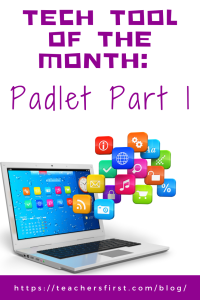Padlet is a simple web application that allows you to create a virtual bulletin board to display information on any topic. There are seven layouts to choose from when setting up your Padlet board that control how information is presented (including a timeline and map!). Users can add images, links, videos, texts, drawings, and more to their virtual sticky notes. Users can also comment on other responses (if the original creator enables that option). A free account allows you to make 3 Padlets per email address that registers to use the site. You can delete older Padlets to create new ones. There are many background design options (wallpaper and colors). One of the best features of Padlet is that it is device agnostic and available on the web or as an app (on Android and iOS). Please note that students do not need to register to add comments on an already created Padlet. Registration is only required to develop Padlets. Padlets can be shared by the provided URL, QR code, or embedding into a website, email, or blog. Settings allow you to add collaborators, make your Padlet open for public contributions, keep your Padlet private, or create one moderated by you (meaning that you must approve any posted notes or comments before they show). And finally, Padlet is supported in over 40 languages (read about the available languages).
Applying the Triple E Framework
The Triple E Framework, created by Dr. Liz Kolb, believes that “effective technology integration begins with good instructional strategies and not fancy tools” (tripleeframework.com). Dr. Kolb wrote a book on the topic, Learning First, Technology Second (ISTE, 2017), that lays out the three main uses for technology in education: to Engage, Enhance, or Extend learning goals. We can use this framework to decipher why we use specific classroom tools. Here is a rubric based on the Triple E Framework you can use to evaluate whether Padlet (or any other technology) is a good fit with your learning goals and whether you should use it in your lesson.
- Engage in learning goals: The students are motivated to begin learning as Padlet allows students to answer questions using drawings, photos, videos, and text. These options make the tool more engaging. In addition, Padlet helps students to focus on the content (learning goals) with less distraction, as there are no advertisements or other distractions.
- Enhance learning goals: Padlet creates paths for students to demonstrate their understanding of the learning goals in a way they cannot do without technology. For example, students can click and instantly collaborate with others virtually. Students can add comments on maps and timelines with a simple click.
- Extend learning goals: Dr. Kolb describes extended learning as an opportunity for students to learn, connect, and collaborate outside the regular school day and bridge the school day and real-life experiences. Padlet fits nicely as a remote, flipped, or blended learning activity. The site would also make an ideal asynchronous learning experience; students need the URL (which could be provided using a QR code or embedded). Students can also virtually collaborate on a Padlet in or out of the classroom.
SAMR Connection
The SAMR Model, by Dr. Ruben Puentedura, suggests that technology implementation has four levels. Therefore, we can use this model as a guideline to analyze how we use technology tools in the classroom. For example, using Padlet can be at the Substitution, Augmentation, Modification, and Redefinition levels, depending on what the student is doing.
- Substitution: The substitution level is the most basic level of SAMR and refers to when technology acts as a direct substitute without any functional improvements. An easy example is if students answer a question on a Padlet rather than by using paper and pen.
- Augmentation: At the level of augmentation, the technology acts as a direct substitute and includes some functional improvements. We could take Padlet to the level of augmentation by having students create Padlet responses that include adding drawings, images, links to websites, or videos.
- Modification: The level of modification allows us to make (or modify) the activity into something more integrated with technology, meaning there is significant task redesign. We could use Padlet and move to the level of modification by having students comment on each other’s Padlet comments.
- Redefinition: At the highest level of SAMR, the technology allows the creation of previously inconceivable new tasks. With Padlet, students ages 13+ can create timelines, maps, and other virtual bulletin boards to share with other students and teachers using the provided URL (or QR code). Additional students can post stickies on the Padlet and comment to collaborate.
Please take advantage of Part 2 of the Tech Tool of the Month: Padlet, where we’ll discuss using the tool and classroom ideas. In the meantime, let us know how you have used Padlet in your education setting in the comment section below.



È molto interessante potersi confrontare e arricchire con i nuovi strumenti che la tecnologia ci mette a disposizione!